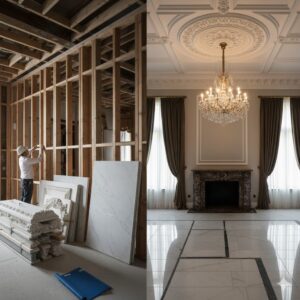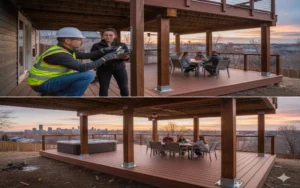That intrusive column in the middle of your living room or kitchen? It stands between you and the open-concept layout of your dreams. Homeowners across the Denver greater area often wonder if they can simply remove it to create a more modern, spacious interior. The short answer is yes, but the process of removing a structural column is a serious undertaking that demands precision engineering and expert execution. This is not a weekend DIY project.
Removing a load-bearing column without a proper plan is like pulling a critical piece from a Jenga tower—the entire structure is at risk. This guide will walk you through the essential process, costs, and non-negotiable safety considerations. To ensure your project is handled with the utmost care from the start, it’s crucial to partner with a firm specializing in Residential Structural Engineering Services in Denver.
Table of Contents
ToggleIs That Column Really Structural? The First Critical Step
Before any sledgehammers come out, you must determine if the column is load-bearing. Some columns are purely decorative, but you can’t assume.
How to Tell if a Column is Load-Bearing
- Check the Plans: If you have the original blueprints of your home, they will indicate which elements are part of the structural system.
- Trace the Load Path: Look at what’s directly above the column. Does a large beam rest on it? Does it align with walls or columns on other floors, continuing all the way down to the foundation? These are strong indicators it’s carrying significant weight.
- Get a Professional Inspection: The only surefire way to know is to have a structural engineer perform an inspection. They can assess the situation and confirm the column’s role. Understanding the cost of this initial step is important, and you can learn more by reading our guide, How Much Does a Structural Engineer Inspection Cost in Denver.
Attempting to remove a load-bearing column can cause floors to sag, create severe cracks, and in the worst-case scenario, lead to a catastrophic collapse.
The Engineering Solution: How to Safely Remove a Column

Once confirmed as load-bearing, the engineer’s job is to design a new system to carry the load that the column was supporting. This isn’t magic; it’s a calculated redistribution of forces.
The Replacement Beam: The Heart of the Solution
The most common solution is installing a new, stronger beam in the ceiling to span the entire open space. This beam will carry the load previously held by the column and transfer it to the supporting points at either end.
Types of Beams Used
Beam Type | Material | Best For… | Considerations |
LVL (Laminated Veneer Lumber) | Engineered Wood | Standard residential spans, cost-effective. | Can be bulky and require a deeper ceiling recess. |
Glulam (Glue-Laminated Timber) | Engineered Wood | When you want an exposed wood beam look. | Aesthetically pleasing but can be more expensive than LVL. |
Steel I-Beam (W-Flange) | Structural Steel | Long spans, heavy loads, or when ceiling height is limited. | Very strong and compact, but heavier and requires more labor to install. |
The engineer performs detailed structural engineer calculations to determine the exact size, material, and specification of the new beam. This calculation is a core part of the Residential structural design process.
Reinforcing the Foundation
A crucial, often overlooked, aspect is the foundation. The load from the old column was a single point of pressure. The new beam now transfers that entire load to two new points. The engineer must verify that the foundation and framing at these points can handle this concentrated new load. If not, they will design a solution, which could involve:
- Adding new footings under the foundation.
- Strengthening the existing foundation.
- Adding new posts within the walls to transfer the load down correctly.
Ignoring this step is a recipe for future trouble. It can create new stress points and lead to Signs of Foundation Problems years later.
The Step-by-Step Process for Column Removal
Removing a structural column is a carefully orchestrated construction project.
- Engineering & Design: Hire a structural engineer to assess the site, perform calculations, and create a detailed set of drawings and plans. This defines exactly what needs to be done. For a deeper dive into what this role entails, see our article, What Does a Structural Engineer Do.
- Permitting: Submit the engineer’s plans to the building department in the Denver greater area. A permit is always required for altering a building’s load-bearing structure. Work cannot begin until the permit is approved and issued.
- Temporary Support (Shoring): Before the column is touched, the contractor builds temporary walls or posts on either side of it. This shoring holds up the structure’s weight while the work is being done.
- Demolition and Removal: The old column is carefully removed. Drywall and finishes around the area are opened up to install the new beam.
- New Beam Installation: The new, properly sized beam is lifted into place and securely fastened to the support points as specified in the engineer’s drawings.
- Load Transfer: The temporary shoring is slowly removed, allowing the new beam to take the full weight of the structure. The engineer may perform an inspection at this stage.
- Finishing: Once the structure is secure, drywall, electrical, and other finishes are repaired and completed.
The Cost of Removing a Structural Column in Denver
The cost to remove a load-bearing column can vary significantly based on several factors. It’s not just the price of a beam; it’s a comprehensive project cost.
Key Cost Factors:
- Span of the Opening: A longer span requires a larger, more expensive beam.
- Load on the Column: A column supporting a second story and a roof carries more load than one just holding up a ceiling.
- Beam Material: Steel beams are typically more expensive than LVL beams.
- Site Accessibility: How difficult is it to get a long, heavy beam into the house?
- Foundation Work: If the foundation needs reinforcement, this will add significant cost.
- Finishing Work: The cost to repair drywall, paint, flooring, and potentially re-route electrical or HVAC lines.
In the Denver greater area, a straightforward column removal project can range from $5,000 to $15,000. However, for complex projects involving very long spans or significant foundation work, costs can exceed $25,000 or more.
Conclusion: Opening Up Your Space the Right Way
Removing a structural column is one of the most impactful ways to transform the feel of your home. It creates flow, light, and a modern aesthetic. But it is a project where cutting corners on engineering or permits can have devastating consequences for your home’s safety and value. By partnering with an experienced structural engineer and a qualified contractor, you can ensure your vision is realized safely and successfully.
Have a column you’re ready to remove? Let’s discuss how to do it right. Contact ISTA Engineers for a professional consultation.
📞 (720) 740-4060 📧 info@istaengineers.com
Frequently Asked Questions (FAQ)
Can I remove a central pillar in my living room?
Yes, it is almost always possible to remove a central pillar, provided a proper engineering plan is developed. A structural engineer will design a new beam and support system to safely redistribute the load the pillar was carrying. Do not attempt this without professional plans and permits.
How much does it cost to remove a load-bearing column?
The cost varies widely, but for a typical residential project in the Denver greater area, you can expect to pay between $5,000 and $15,000. Complex projects with long spans or foundation modifications can cost significantly more. The final price includes engineering fees, materials, labor, and finishing work.
What permits are needed to remove a column?
You will need a building permit from your local city or county building department. This is not optional. The permit application requires a full set of plans stamped by a licensed structural engineer. Working without a permit can lead to fines, work stoppage orders, and major issues when you try to sell your home.
What is an alternative to a structural column?
The most common alternative is a concealed beam, typically an LVL or steel beam hidden within the ceiling cavity. This creates a completely open span. In some cases, if a full span is not feasible or is cost-prohibitive, alternatives could include creating two smaller openings with a decorative column between them or re-routing the load path through other structural changes.





One Response